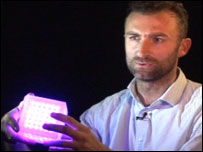Touch cube points to future toys
By keminem001
@keminem001 (779)
Saint Lucia
December 25, 2007 1:58pm CST
Thousands of people will be unwrapping their shiny new gadgets at Christmas but one British artist and engineer is hoping his creation will find its way under trees in time for the next festive period.
Andrew Fentem has worked on innovative human computer interfaces for some time, after beginning his career in military research and development, specifically missiles.
His work today is part-art, part hobby, part business venture.
His latest creation, the Fentix Cube, is generating a lot of interest from toy manufacturers and buzz on the internet, based on a few clips he put on YouTube.
"Because of absurd level of interest generated by YouTube everyone wants the device," he says. "I'm being bombarded by toy firms from Korea."A small plastic cube with playful lights, it could be mistaken for a mass market throwaway toy manufactured by the million in the Far East.
But the colourful exterior masks a combination of innovative technologies that have propelled Apple's iPhone and Nintendo's Wii to huge success this year.
The cube contains a large battery, an array of LEDs and crucially three accelerometers which can detect the pitch and yaw of the device, and sensors on the inside surface for touch control.
Mr Fentem says: "You instinctively know how to use it. The way you understand the world as a young child is through physical and spatial awareness, up or down. It's how you learn and communicate."The accelerometers are essentially chips which can sense the direction of gravity; once you know that, you can work out which way is up and down.
"It took about a month to build; I thought it would be nice to do a cube computer after I had seen an electronic Rubik's cube, which was very poor."
The cube has been programmed to play a handful of games, such as a PacMan-inspired maze game. But the combination of touch, light and three dimensions opens up a range of possibilities - from music games, to puzzles and even a lifestyle device.
Mr Fentem said he was inspired to build the cube because he was dismayed by the quality of many of today's electronic toys.
"This was originally an artistic intervention into the gadget market. If you really want to make something unusual, you really have to understand the physics of how things work.
"Because most people don't know much about engineering, the ideas tend to be poor."Up until the age of 22 Mr Fentem worked at Thorn EMI on highly classified projects, and had to sit in a Faraday cage, a shielded space which prevents any sort of transmission in or out.
Disillusioned by the industry he moved to London and fell into the art and electronics scene.
Much of his work is displayed at the Kinetica gallery, the UK's only space dedicated to electronic art.
His previous designs include multi-touch screen interfaces for musical applications, which won him an innovation award from the National Endowment for Science, Technology and the Arts.
He has also worked on touchscreen surface technology, for creating musical scores, playing games, interactive floors and artistic purposes.
He says the cube is designed partly as a calling card for investors and companies."I'd like the cube to go mass market. I'd like to see it in people's homes. But if it only serves as an introduction to my work, I'll be happy."http://news.bbc.co.uk/2/hi/technology/7156414.stm
1 person likes this
No responses




